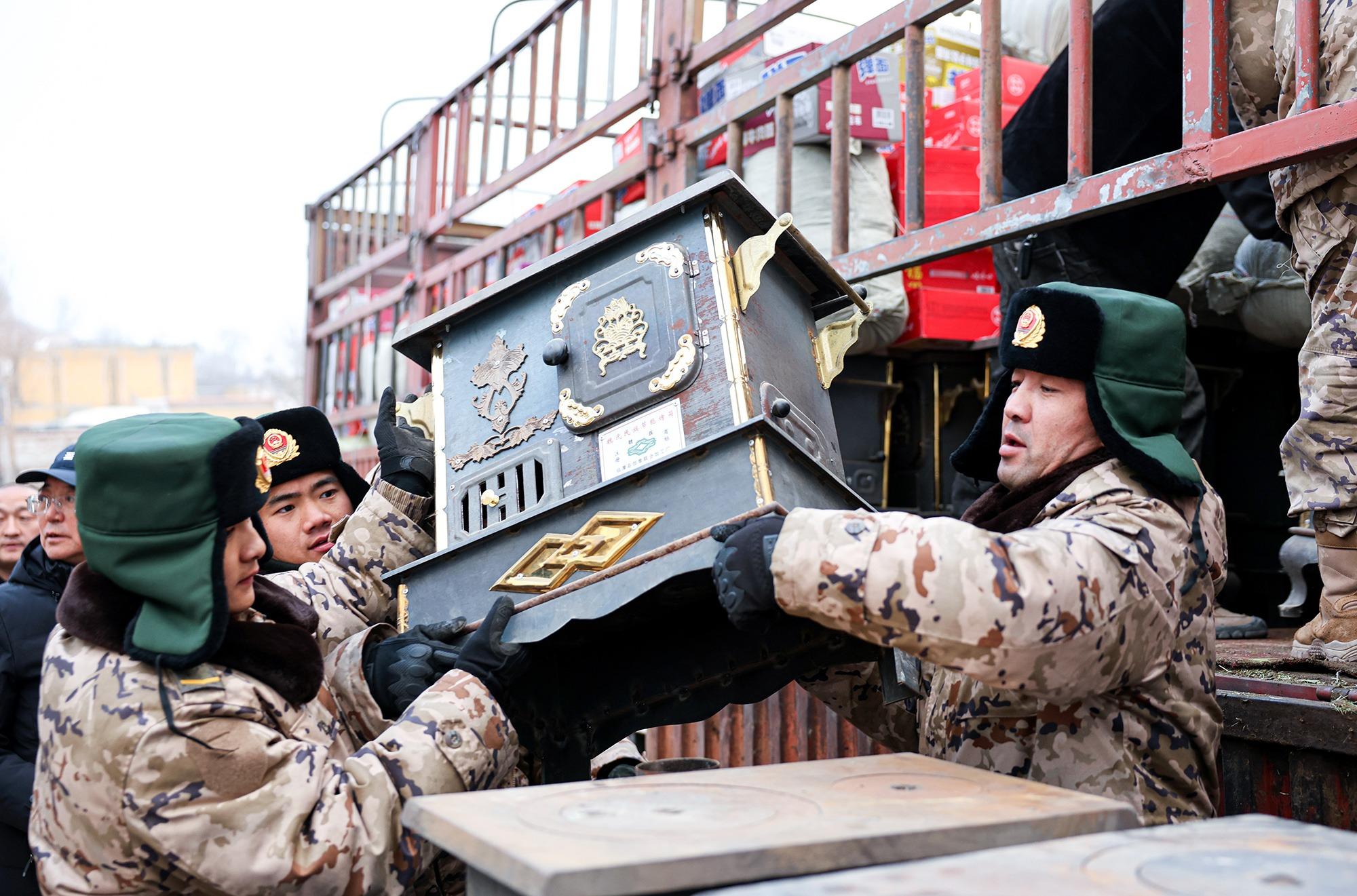 Members of a relief team unload traditional metal wood-fired stoves on Dec 19, 2023 to provide heating for earthquake victims in Jishishan county in Linxia, Gansu province. (PROVIDED TO CHINA DAILY)
Members of a relief team unload traditional metal wood-fired stoves on Dec 19, 2023 to provide heating for earthquake victims in Jishishan county in Linxia, Gansu province. (PROVIDED TO CHINA DAILY)
A bonfire at a temporary shelter in Jishishan county, Gansu province, near the epicenter of Monday's magnitude 6.2 earthquake, rekindled among survivors the hope of rebuilding their lives after the disaster as they endured frigid temperatures in the remote mountains of northwestern China.
Huddled inside a tent with her family, Ma Nuer, a resident of Kexinmin village, located near the epicenter, recalled how their house turned into a pile of rubble within a matter of seconds.
"The quake struck just before midnight. My husband, our two sons and I rushed to the nearest exit — a window — and jumped out. Our house collapsed in front of our eyes in 10 seconds or so," the 32-year-old woman said.
The family spent the first few hours after the disaster shivering in the open. "The rescuers arrived and put up tents for us. We were given noodles and baked buns."
Ma said she knows that rebuilding their lives from scratch won't be an easy task, but the swift mobilization of aid for the survivors has given her immense hope.
"I don't know what happened to our belongings, or whether we can salvage anything at all. But at least tonight, my family and I have fire and a shelter to keep us warm," she said.
Kexinmin village, which has a population of around 1,400 people, is among the areas hardest hit by the quake in Jishishan county, which is located in Gansu's Linxia Hui autonomous prefecture. Hundreds of displaced villagers were relocated to three temporary shelters by Tuesday evening.
As of Wednesday morning, the earthquake had killed more than 130 people and injured hundreds in Gansu and neighboring Qinghai province.
An inspection conducted at the Liujiaxia Hydropower Station showed that the dam and other facilities, including the spillway structures, were functioning normally, the team said. China's first megawatt hydropower station is located around 50 kilometers from the epicenter. The quake was strongly felt in the area, which prompted a level IV emergency response.
Search and rescue efforts ended at 3 pm on Tuesday, and priority work now includes treating the injured and rehabilitating the displaced, the team said at the news conference.
By Wednesday morning, 130,000 relief items, including tents, stoves, quilts and folding beds, had been sent to the quake-stricken areas.
A total of 87,076 people from 20,457 households had been relocated to temporary shelters, according to the Gansu provincial emergency management department.
Adequate food and heating arrangements have been made at these shelters. Provisional dwelling units are being set up to ensure each household has at least one fully insulated tent for the winter. Daily necessities, water and electricity will be guaranteed at these relocation sites, according to the department.
Wang Xihong, a member of an emergency rescue team administered by the Gansu branch of Red Cross Society of China, said he arrived at Kexinmin village around 3 am on Tuesday and has been working nonstop since, looking for trapped residents, removing debris on roads and setting up shelters.
"I need to catch a few winks of sleep, but taking a break is not on my mind right now. We have to help as many people as possible. Our top priority is keeping everyone warm in this frigid weather," he said.
Early Wednesday, a truck loaded with 1,440 quilts and 150 folding beds arrived at Kexinmin. "We still need more quilts and jackets to keep the chill out at night," Wang said.
The insulated tents being set up for quake survivors are designed to last at least three months, according to Wang. "More equipment and materials are being transported to build outdoor toilets and infrastructure to ensure clean water," he added.
To ensure smooth supply of relief materials to the affected areas, the Gansu transportation department swiftly cleared highways, expressways and rural roads that were buried in debris during the quake. Green channels have been set up at toll stations leading to affected areas to provide all relief vehicles free passage.
Planning for post-disaster reconstruction work has also started. The local authorities are consulting experts in various fields to assess the extent of damage to make preparations for a speedy all-around recovery.
Zhang Yu and Zhao Ruixue contributed to this story.
Contact the writers at wangxiaoyu@chinadaily.com.cn


